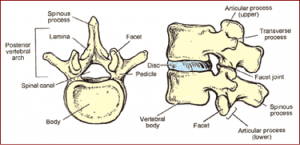
We’ve all heard it before, whether it be a friend, neighbour, work colleague or GP. The term “slipped disc” does get thrown around quite often. Depending on who you speak to it can mean many things but what exactly is a “slipped disc”?
For those keen anatomists amongst us here is a quick overview of the spine, in a very basic way.

Looking at the picture above, we can see that there are two bones or vertebrae, which are separated by a disc, shaded blue. The disc can be thought of as a cushion or shock absorber between the bones. In our spine, we have discs between our cervical vertebrae (neck), thoracic vertebrae (upper back) and lumbar vertebrae (lower back).
Each disc is made up of three basic structures:
Depending on what part of the spine the disc is in (ie cervical, thoracic or lumbar) will have a different percentage composition of three main components:
As we can see the inner nucleus pulposus which is blue, is the centre of the disc. It is composed mainly of water and is gelatinous (think thick jelly) in the centre. It can withstand high pressures, and is under most pressure in a seated or flexed (bending) position.
The outer layer, in green is much more fibrous than the nucleus. It has a higher percentage of collagen and is a lot tougher, it has less water than the inner nucleus pulposus. Its job is to hold the inner nucleus in place.
Over time, due to natural wear, increased load (jobs which require repetitive bending, lifting and straining) or sometimes just due to bad luck, our discs can become damaged. The picture below shows different injuries that can occur to our discs.
Degenerated discs are usually due to the Annulus Fibrosus or out-layer of the disc starting to wear away. The collagen starts to wear away with time and the disc starts to degenerate.
A bulging disc which is most commonly referred to as a “slipped disc” is when part of the annulus fibrosus or outer layer, starts to bulge out of its border. This can lead to sharp pain, pain with bending or sitting, pain with standing for extending periods and can sometimes cause referred pain down the leg. A high percentage of us will have a disc bulge at numerous levels at not have any symptoms, usually with Physiotherapy the symptoms of a disc bulge can be reduced and a patient can return to pain free activity.
A herniated discs, refers to a tear in the outer layer of the disc (Annulus Fibrosus) which can lead the inner Nucleus to spill out. This injury can be more severe. Herniated discs can be associated with the same symptoms as a disc bulge, and too can be treated, however, if symptoms do not settle may require further intervention from a neuro-surgeon.
A thinning discs refers purely to the size of the disc decreasing, this is usually associated with age and can be affected by increased weight.
As you can see there are a few possible disc injuries that can happen. If I haven’t lost you yet, here’s something else to wrap your head around.
A very separate issue known as spondylolisthesis is the forward slipping of the vertebrae (bone) in one or numerous segments of the spine. Unlike the disc, this has to do with the bone itself moving too far forward. This can be due to anatomical issues with the spine, specific movements or repetitive forward bending postures, weakness of our core muscles that hold our spine in place or a combination of all three.
As we can see on the X-Ray below, L4 has moved forward or “slipped forward”. So in reality the bone itself has moved forward as opposed to the disc.
Confusing right? Back pain can seem this way, and terms like “slipped disc” sometimes can cause more harm than good. As you may have gathered, it technically isn’t possible for a disc to slip, but more the bone itself.
When you experience back pain, you may go to the GP and get told that you have a “slipped disc”. If that is the case it’s not all doom and gloom. As you have now seen there are many disc related issues, and most of them can be treated and managed under the care and guidance of one of our Physiotherapists. We will be able to go through your scans or determine if any are required, discuss your underlying issue and provide you with the best possible treatment and exercises to keep you moving and pain free.
So next time you have back pain, come see us about it, we can help!

Jude Holroyd is the Principal Physiotherapist at The Healthy Body Company in Jordan Springs. You might be interested in other articles written by Jude including:
We also have more information about lumbar spine pain, neck pain and upper back pain that might be helpful.